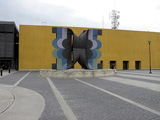




 Bogota, the city, displays Colombia’s capital city throughout five epochs. It is a somewhat nostalgic chronicle of by-gone times forever associated to the youthful experiences of the authors of this book. These pages show how the ceremonious City of grand occasion furs and dress hats, Prince Albert coats and top hats, changes through the years into a more informal metropolis whose symbols could very well be the jeans and sneakers of the new off springs.
Bogota, the city, displays Colombia’s capital city throughout five epochs. It is a somewhat nostalgic chronicle of by-gone times forever associated to the youthful experiences of the authors of this book. These pages show how the ceremonious City of grand occasion furs and dress hats, Prince Albert coats and top hats, changes through the years into a more informal metropolis whose symbols could very well be the jeans and sneakers of the new off springs.
Likewise, today’s housing developments are worlds apart from the XVI Century’s 25 narrow and well laid out city blocks between the San Francisco and San Agustin rivers. Former President Alfonso L6pez Michelsen’s text brings to life his childhood nooks and crannies, the lumbering trolley cars, Holy Week processions and the student 20’s carnival sweetheart queens, when our City was still elegant and parochial inhabited by pure bred Bogotanos.
The once Capital City, once alien to today’s dizziness, lived in peace until the end of the 40’s of which we have Daniel Rodriguez’ keen reporter eyes, his cameras and well preserved shots of panoramas and characters, Plinio Apuleyo Mendoza, the well-known journalist and writer, has managed a beautiful evocation of Bogota during the 40’s. Clinging to his remotest childhood remembrances is that era forever gone with the smoke of the April 9, 1948 riot ashes. Almost Impressionist-like his chronicle paints the City’s then social scene without leaving anything out: not the masses electrified by Gaitan’s fiery speeches, not the provincial middle income folks making-up his flock, not the uppity folks, fretting in the almost totally gone mansions lining the tree filled El Retiro and La Cabrera posh neighborhoods. Daniel Samper, with his always graceful writing, tells us about another City belonging to another generation AhisA catering to the Beatles, the Cuban Revolution, to the awe inspired by One Hundred Years of Solitude and to the A flower to chew song by Oscar Golden, a standard lyric of those defying, long haired, crazy dress 60’s.
A totally tumultus youth, today nature adults, relive through his pages., Miguel Silva, tells us about the “new Medieval city which at the beginning of the 1980’s was one city, but turned into many cities in less than ten years, some modem and attractive, even with somewhat of a personality. Lastly, journalist and anchorman Jorge Alfredo Vargas discovers for us the new millennium Bogotá with its grand parks, cycle-routs, wide sidewalks and unheard of traffic-packed avenues. The city we are showing in this book is this new, turbulent city with closed to seven million inhabitants, extending to its south and encroaching on the vast savanna to the north where a huge and vane middle-income population lives Our picture journey begins at the crossroads of the new Bogota: Avenida Chile. We continue north, east and west, stopping to enjoy its most recent architectural offerings, its malls and new housing developments. Naturally, without overlooking what remains of a colonial past happily preserved in neighborhoods as La Candelaria, in churches and convents. In short, what we seek is a trip to the past and into the future of this Capital City belonging to all, whatever one’s origin. Behind its vertiginous growth, it has left many a melancholic footprint on several generations. Article written by C o n s u e l o Mendoza D e R




